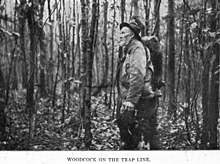The examples and perspective in this article deal primarily with Canada and do not represent a worldwide view of the subject. (April 2014) |


In the fur trade, a trapline is a route along which a trapper sets traps for their quarry. Trappers traditionally move habitually along the route to set and check the traps, in so doing become skilled at traversing remote terrain, and become experts in the geography of the local area. Because of this traditional knowledge, traplines are not only of interest to trappers themselves but to researchers and others (governments, corporations) interested in local history, biology, and topography. The assignment of particular trapline territories to individuals in band societies was traditionally handled by group consensus, and occasionally violence and warfare. In the present-day trapline assignment is typically formalized and controlled by the state. Formalized trapline territory boundaries now form the basis for many major land-use projects in fur-rich regions.
One of the entitlements that goes along with possessing a trap territory is the right to erect a trapper's cabin: a simple shelter in which a trapper can stay while moving around his territory. Trappers' cabins are a cultural icon of fur regions, and an important part of the national mythos of countries and regions such as Canada and Alaska, and among groups such as the Métis.